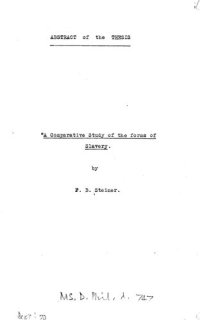
Ebook: A comparative study of the forms of slavery
Author: Steiner Franz B.
- Tags: Sociology Anthropology Slavery
- Year: 1949
- Language: English
- pdf
This thesis is composed of three parts all of which are to form the introduction to a general sociology of slavery. The first part is a theoretical introduction. In it first of all the meaning of the word 'Slave' is discussed, but the word is not defined as a scientific term. The changing and accumulating meanings are illustrated from 18th and 19thcentury dictionaries. Thus some insight is gained into our conditioning in using the word, and pseudo-scientific questions,arising out of this accumulation of meanings can be excluded from our inquiry. Placing slavery in a classification of the institutions of social inequality, we can define “servile institutions" as institutions 'sui generis', just as the three other main kinds: rank systems, class and caste structures. The relation between servility and the organisation of labour is outlined. This necessitates some general remarks on the meaning of ‘labour' as a sociological term which tend to be rather critical of attempts to describe labour in terms of motives. Two types of labour are thought to be particularly important in relation to servility: communal labour, that is the performing by many in unison of the same work, and menial labour, which, in the sense used here, causes a person to be exempt from the application of the sexual division of labour. The next section deals with relationships existing between individuals which involve a degree of servility, but do not express a desire to have this servility perpetuated, which thus does not form part of the basic structure. These institutions called here pre-servile which sometimes are confused with Slavery, develop in processes of social integration of detached persons (prisoners of war, offenders, orphans, bastards etc.)and are distinguished from pure slavery. The third part deals with a group of pre-servile institutions arising out of economic symbiosis of two societies of different 'densité morale'. In these institutions of extra-tribal patronage and servile symbiosis we find arrangements of social asymmetry and a tendency toward servile forms of labour which is rare in the former group of pre-servile institutions. Home attention is given to the relation between structural permanence of the institutions and the differentiation of labour forms. There exists a correlation of this kind, but no causal nexus.
Download the book A comparative study of the forms of slavery for free or read online
Continue reading on any device:

Last viewed books
Related books
{related-news}
Comments (0)